Menu
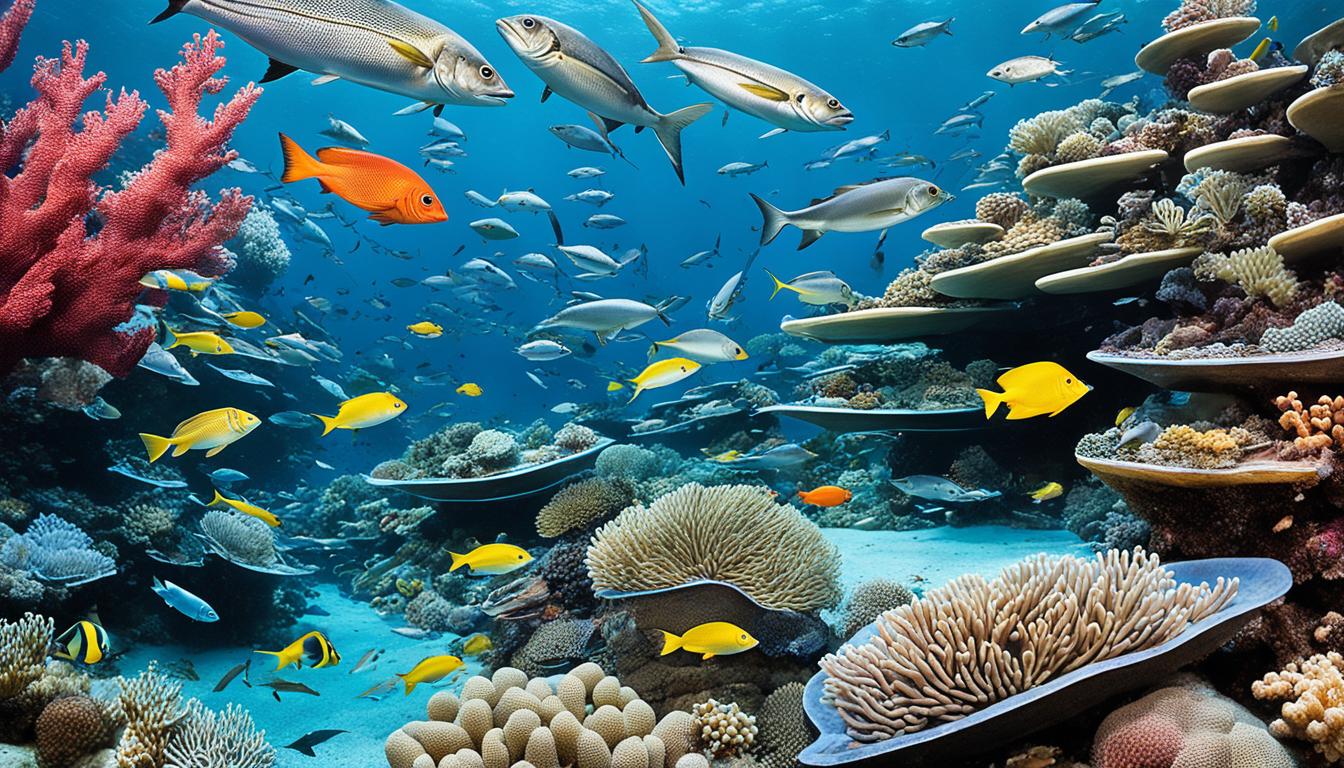
Over 35% of the world’s fisheries are overfished, which is a huge problem for our oceans. Fish consumption has gone up faster than the human population. Nearly 60% of our global fisheries are fished to their limit. This is why we must work hard to fight illegal fishing. The effects of overfishing are serious, threatening not just fish but also our food and the sea’s health.
Today, technology makes overfishing worse, especially in tropical waters. Countries like China, Taiwan, Japan, South Korea, and Spain use their large fishing fleets in other countries’ waters. This harms local fishers and makes sea crime worse.
We are fighting these problems by using new tech like the Global Fishing Watch (GFW). It has AIS and VMS to watch over fishing. But illegal fishing is still a big problem. The EU tries hard because it buys a lot of seafood. Yet, it’s tough to completely stop the selling of illegal fish. Groups like the WWF EPO are working with the EU to make fisheries better. But there is a lot more work to do to stop illegal fishing.
Overfishing is a big issue today. It’s making it hard to keep up with the number of fish in the sea. As more people eat fish, the oceans are struggling to feed everyone. Most of the fish we eat come from the Indo-Pacific region. The high demand for fish has led to catching more than nature can replace.
The number of fish in the world’s oceans is dropping fast. This is bad news for our planet’s seas and the food some people need. Many rely on fish for a good part of their diet. But catching fish in ways like bottom trawling is causing big problems.
Bycatch is a big issue with bottom trawling. It means catching other sea animals unintentionally. This includes whales, dolphins, and turtles. It puts them in danger of disappearing forever.
The way we catch fish is also hurting the sea’s homes. Methods like deep-sea bottom trawling are very destructive. They destroy habitats, including very old deep-sea corals. This makes it hard for these habitats to recover.
We’ve tried to make rules to fish more sustainably. Laws like the Magnuson Stevens Act aim to protect fish numbers. But we’re still catching fewer fish than before, especially since 1989.
We really need to work together to save our oceans. It takes everyone helping out. With strong plans and everyone pitching in, we can make the oceans healthy again.
Illegal, unreported, and unregulated (IUU) fishing is a big problem leading to overfishing. It makes up about 14-33% of all legally caught fish. This kind of fishing hurts marine life and the economies relying on fishing.
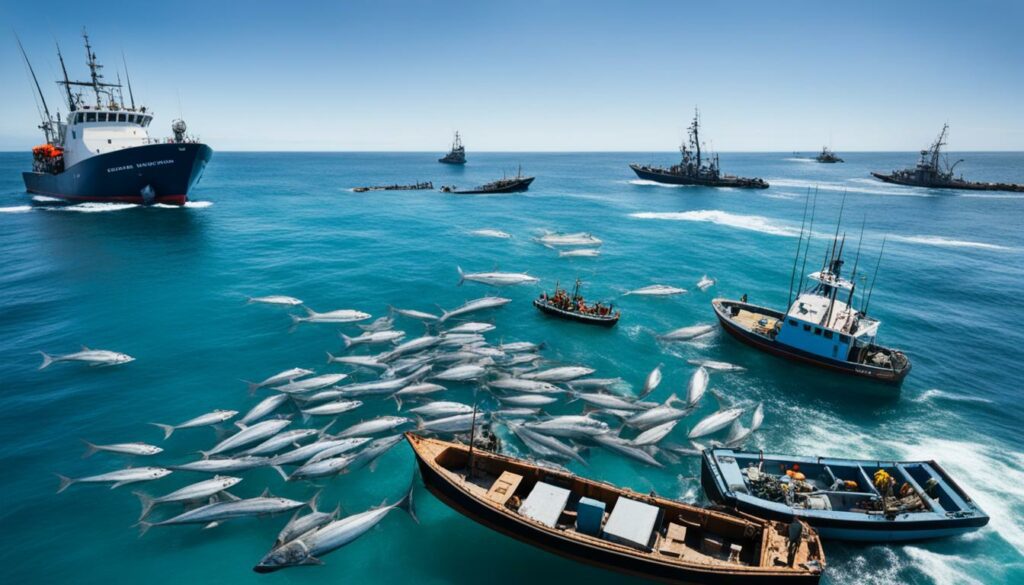
Estimates show IUU fishing catches a lot of fish illegally. In areas like West Africa, it’s 40%. In the Pacific, it’s 34%. Countries like China and Russia often fish illegally in places like the Northwest Pacific Ocean, making up 33% of the catch.
In the Southwest Atlantic, it’s 32%. They mainly target valuable species like cod and salmon. This makes it hard for these fish to recover from being overfished.
Illegal fishing causes big economic losses. These losses total up to billions every year globally. To fight IUU fishing, a lot of money is needed. Countries like Norway put a lot of resources into stopping illegal fishing.
The world’s biggest fish market, the United States, has rules to keep illegally caught fish out. The Seafood Import Monitoring Program is an example. Laws like the Magnuson-Stevens Act aim to make fishing rules stronger.
Stopping IUU fishing needs the whole world working together. Effective rules are crucial to protect the sea and keep fishing sustainable.
Fisheries crime is a big part of the overfishing crisis. Not every case of overfishing links directly to Illegal, Unreported, and Unregulated (IUU) fishing. But, IUU fishing makes the problem worse. About one in five fish may come from illegal sources, showing how big the issue is.
Illegal fishing uses banned methods and gear. This results in too much bycatch, which harms other sea life. It also makes it harder to keep our seas healthy. Bycatch upsets the natural order of the ocean. This makes it tough to follow eco-friendly fishing and fair reporting rules.
Globally, more than a third of fish stocks are overfished. This is seen in the drop from 90% to 65.8% of stocks in 1974 and 2017. These numbers are worrying. They show we must fight illegal fishing with strong rules and by saving ocean life.
The UN’s UNCLOS and FAO create rules for fishing. But making sure these rules are followed is hard. For example, many fishing organisations don’t always check what boats are doing. Having people on boats to watch is important but not always done.
Richer countries like China and Japan do most of the fishing in international waters. This leaves poorer nations at risk. Their fishing industries suffer, making global fairness and ocean crime worse.
To solve this problem, countries need to work together. They should make fishing rules clear and stop corruption. Protecting the ocean and fighting illegal fishing will help keep fish around for the next generations.
The use of advanced methods has greatly increased our ability to watch over fishing around the world. It makes sure that more sustainable methods are followed.
Automatic Identification Systems (AIS) help make the seas safer. They track ships almost immediately, showing authorities who might be breaking fishing rules. By combining AIS with other tech, we help keep the oceans healthy.
Vessel Monitoring Systems (VMS) give a close look at what ships are doing by sharing where they are. This helps enforce laws that protect our sea life and keep fishing in check. With the data from VMS, we can check if ships are fishing legally and work to stop illegal fishing.

Satellite data and smart algorithms have changed the way we work for ocean health. Tools like Eyes on the Seas match ship locations with their activities, spotting anything fishy quickly. This tech lets us monitor the seas live and catch illegal activities faster. It’s a big step towards fishing that is sustainable everywhere, helping us understand fishing trends around the world better.
The world is finding out how crucial it is to preserve our fish stocks. This has led to strong laws internationally. Two big ones are the UNCLOS and UN Fish Stocks Agreement. They make countries work together to look after fish in a way that lasts.
The UNCLOS shapes the rules for the oceans, focusing on who can do what with the resources. It helps by sharing out the sea areas. It says which parts coastal countries can control, and that the rest we should manage together. This way, it supports keeping fish populations healthy for the future.
The UN Fish Stocks Agreement adds to the UNCLOS by dealing with certain fish. These include fish that cross places and those that move a lot. It aims to be careful and think of the whole environment when catching fish. This helps make sure we fish in a way that’s good for everyone. Coastal and fishing countries work together to make this happen.
Regional Fisheries Management Organizations (RFMOs) play a key role in making sure fisheries are managed sustainably. There are about 17 of them, with a focus on tuna. They cover almost all the oceans. These organisations work on keeping fish stocks healthy, especially for fish that move around a lot, like tunas.
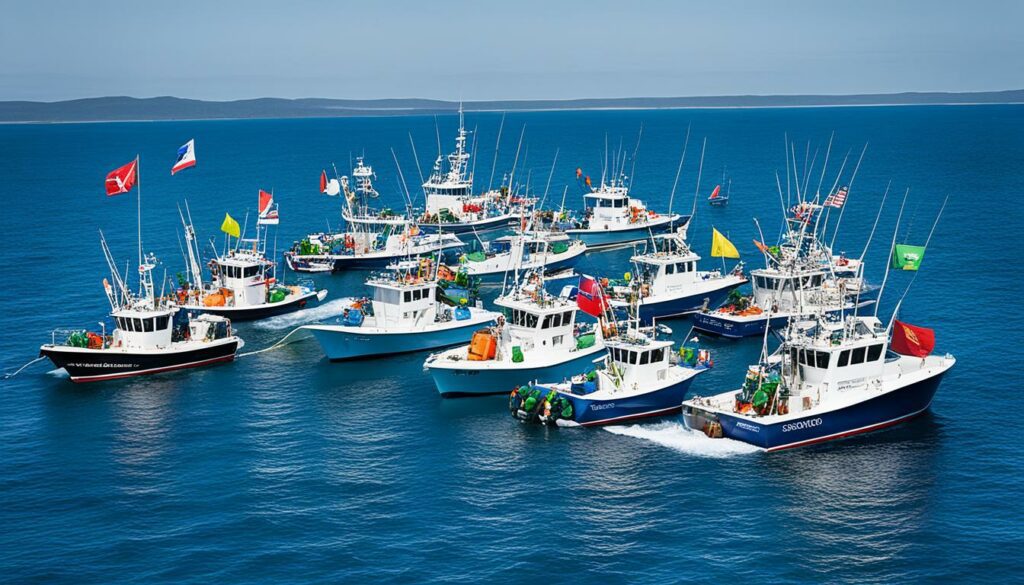
The European Union is a part of 10 RFMOs, showing a strong commitment to managing fisheries globally. It takes part in groups that look after tuna, like ICCAT and WCPFC, and others that don’t, such as NEAFC and NASCO. This means the EU’s fishing fleet catches around 839,000 tonnes of fish outside EU waters. That makes up 18% of all the fish it catches.
RFMOs face some challenges, like needing better teamwork. They work to set fishing limits based on what scientists say is safe. But sometimes, political reasons mean they let people catch more fish than they should. Some progress has been made with keeping track of catches and watching fishing boats. However, not all ships are registered everywhere they fish.
Even though RFMOs are important, they find it hard to stop overfishing and keep fish stocks healthy. This is partly because the rules aren’t strong or clear enough. Also, there isn’t always a strong reason for countries to follow the rules. It’s crucial to fix these problems to protect fish for the future.
Dealing with these issues means all these organisations need to work together better. They must fight illegal fishing, making sure everyone plays fair. With strong, united steps, we can ensure fisheries are managed in a way that keeps our oceans full of fish for years to come.
The United States is a key player in the fight against illegal fishing. They have made detailed plans to address this global problem. These plans involve many government bodies working together. They also use the latest technology and partnerships. The National Five-Year Strategy is a big part of their approach. It focuses on working closely with important countries in the fight against illegal fishing. The aim is to make use of tools we already have and new technologies.
The U.S. Coast Guard is at the forefront of this battle. It is responsible for enforcing fishing laws in U.S. waters, including a vast ocean area. By using intelligence, they focus their patrols where they are most needed. This means they can help other countries protect their waters more effectively.
The Coast Guard works closely with other nations to make sure fishing rules are followed. They believe that by working together, they can achieve much more. They are focused on being innovative and building strong partnerships to stop illegal fishing.
NOAA is a key part of the U.S.’s plan to fight illegal fishing. It is part of a big team that includes 21 different government organisations. This team is working hard to put the national strategy into action. They aim to improve how fishing is controlled and make sure everyone follows the rules.
NOAA is all about pushing for good fishing practices and making sure the rules are kept. They are particularly focused on helping five key countries improve how they manage their fishing. This will help stop illegal fishing by ships from these places. They are also working closely with the private sector to find new ways to tackle this issue.
| Agency | Primary Role | Key Strategies |
|---|---|---|
| U.S. Coast Guard | Enforcement of Living Marine Resource Laws | Intelligence-driven Operations, Accountability, Partnership |
| NOAA | Promote Responsible Fishing Practices | Public-Private Partnerships, Technological Innovation |
The European Union’s zero tolerance policy fights illegal fishing and overfishing. It’s key in the global fight to protect sea life and ensure there are enough fish for the future. The EU, as the top seafood market, brings in about 70% of its seafood. So, it plays a big part in stopping bad fishing practices.
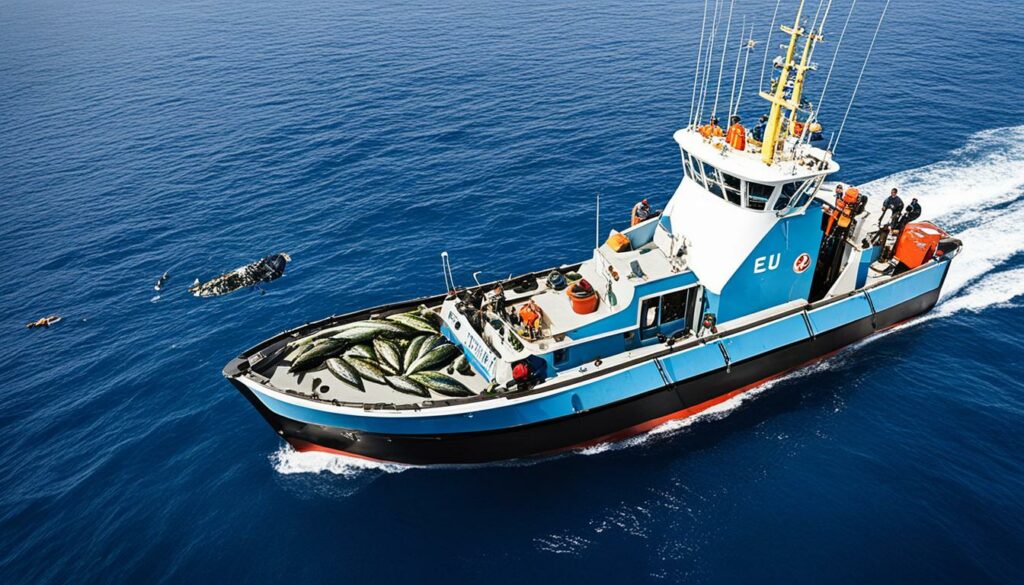
The EU has strong rules under the IUU Regulation. These rules target illegal, unreported, and unregulated fishing. Their goal is to track seafood and make sure it’s caught legally. This makes the seafood industry safer and more sustainable.
The EU works with the WWF EPO and the EU IUU Fishing Coalition to keep a close eye on imported seafood. They want to check if it meets legal standards. But, these checks aren’t always done the same way in every EU country. This causes problems in the EU’s plan to stop illegal seafood from being sold.
Stopping bad fishing not only saves sea life but also brings big money benefits. By ending illegal fishing, the EU’s seafood industry could make more than €49 billion each year. This shows why it’s so important to enforce the EU’s zero tolerance policy strongly.
But, the world’s fish stocks are in trouble. More than 35% of fisheries are overfished, and almost 60% are fully used. In 2019, fewer than 0.01% of imports were rejected. This shows we need to do more to check and stop illegal fishing. The European Court of Auditors is suggesting using the EU’s IT system better. This could help find fraud and make checks more automatic, making sure rules are the same for everyone.
| Year | Global Losses from IUU Fishing (€ billion) |
|---|---|
| 2006 | 21 |
| 2019 | Estimated Increase of Over €49 billion in EU’s Seafood Industry Profits |
The EU’s zero tolerance policy is vital for fighting illegal fishing. It aims for a future where fishing is good for the ocean and makes money. Making sure everyone follows the rules and is clear about what they do is a big part of this. It shows the EU’s commitment to protecting the sea and making fishing sustainable.
Overfishing is a big problem for coastal communities, especially those in poorer areas. The local fish stocks are dropping fast because of illegal and overfishing. This situation makes life extremely hard for local fishermen who play by the rules.
Up to 20% of fish caught globally comes from this kind of fishing. It means local fishermen lose out economically and face unfair competition.
The effects on coastal communities are many. With less fish to catch, fishermen can’t make enough to live. This pushes some to turn to piracy and smuggling.
This not only hurts the economy but creates social and crime problems too. The seafood sector employs almost 38 million people worldwide. So, when this sector suffers, many are affected.
Overfishing isn’t just about money. It also seriously impacts food security, especially in poorer nations. Fish is a key protein source for over 3 billion people globally.
But, with too much fishing, there’s not enough fish left. This makes it hard to get the food they need. It’s a big concern for nutrition and food security.
| Aspect | Statistics |
|---|---|
| Global Catch from IUU Fishing | 20% |
| Economic Loss Due to IUU Fishing | $26 to $50 billion annually |
| Direct Employment in Wild Capture Sector | 38 million |
| Population Dependent on Ocean for Protein | 3 billion |
| Daily Protein Intake from Fish | 20% |
Protecting our seas is key to keeping our ecosystems in balance. Illegal fishing, like IUU fishing, is a big problem. This makes it important to have big, joined-up plans.

The world loses about $23.5 billion each year to seafood lies and illegal fishing. Nearly a third of seafood sold in the U.S. is wrong labelled. This is bad for sea creatures.
Thanks to illegal fishing, many types of tuna are at risk of disappearing. Indonesia loses about $3 billion each year this way. They’ve kicked out over 170 foreign fishing boats in response.
Illegal fishing is also crushing shark numbers, with 100 million killed every year. Big efforts like WildAid’s and Yao Ming’s are making a difference. 82% of Chinese people might give up shark fin soup.
Tough rules really do cut down on illegal fishing. In areas with strong controls, illegal fishing has dropped by 40%. Fishing wisely can actually grow fish numbers by 30%, showing how crucial good marine care is.
Illegal fishing messes up our oceans and stops us from having good, sustainable fish markets. But, the good news is, more people are choosing fish that’s caught right. This kind of fish is getting more popular every year.
To fight illegal fishing, we need to use the best tech. Things like satellites and smart machines can help keep an eye on fishing boats. Also, checking that countries follow the rules is a must to protect our oceans.
Enforcing rules about fishing worldwide is a big job. The PSMA agreement helps stop illegal fish from getting into harbours. This way, it helps keep our sea life safe.
| Factor | Impact |
|---|---|
| Annual Cost of Seafood Fraud | $23.5 billion |
| Proportion of Mislabeled Seafood in the U.S. | One-third |
| Threatened Tuna Species | 5 out of 8 |
| Indonesia’s Annual Loss due to IUU Fishing | $3 billion |
| Sharks Removed Annually | 100 million |
| Reduction in Illegal Fishing with Stricter Controls | Up to 40% |
Addressing illegal fishing and overfishing is key to long-term marine health and stable fishing. To fight illegal fishing, we must use smart strategies. This helps protect fish around the world and the sea-life environment.
Global and regional cooperation is very important. For instance, the EU tackles about 70% of illegal fishing because it imports so much seafood. It does this through the EU IUU Regulation. This rule enhances transparency and checks in the seafood supply chain to stop illegal fishing.
WWF EPO strengthens these rules through teamwork with big seafood buyers, fishery organisations, and governments. Such teamwork is vital to stop illegal fishing. This is crucial for fighting overfishing and setting better fishing rules.
Making fishery rules clear is crucial. Good records and sharing info can cut down on hidden or wrong fishing which messes up planning. It also makes fishing rules better and more fair.
Using methods that help fish and the sea last is very important. These methods protect fish and where they live. This is needed because many fishing areas are already struggling or used too much. Almost 60% are fished as much as they can be.
We need to look at how subsidies from governments might be encouraging too much fishing. Moving this help to fishing that’s better for the sea can help a lot. Governments are crucial in making sure we fish right for the future.
| Strategy | Objective | Impact |
|---|---|---|
| International Cooperation | Strengthening alliances among global partners | Enhanced regulatory frameworks and reduced IUU fishing |
| Transparency | Ensuring public reporting and documentation | Increased accountability in fisheries governance |
| Sustainable Practices | Adopting ecosystem-based management | Protected fish populations and habitats |
| Subsidy Reform | Eliminating harmful incentives | Support for sustainable fishing initiatives |
A mix of good strategies is necessary to help our seas and keep fishing going. By working together across the world, being clear about what’s happening in fishing, and fishing in ways that help the sea, we protect our oceans. We do this for those who come after us.
Sustainable fisheries management is key to keep fish numbers up and protect the seas. We’ve introduced quota systems and fishing licences. These help stop overfishing and look after the sea.
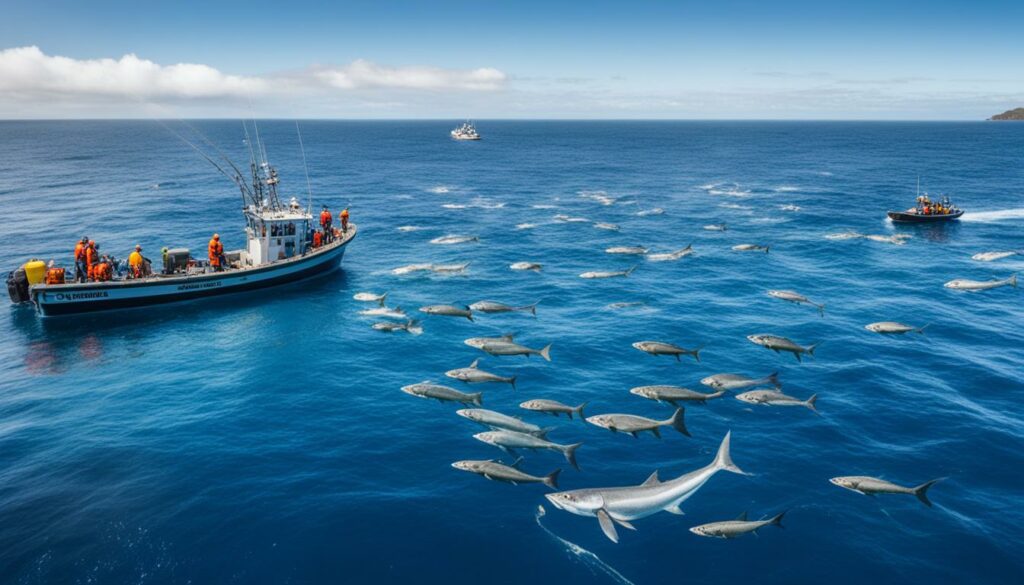
Quota systems are essential for looking after our fish. They set limits on how many and which fish we can catch. Thanks to quotas, species like the bluefin tuna have a chance to recover. Their numbers have dropped to as low as 21 to 29 percent since 1970.
Fishing licences and rules are vital. They keep fishing at safe levels and protect special fish, like the beluga sturgeon. It takes these sturgeons 20 years to grow old enough to reproduce. Licences make sure fishing is done in a way that doesn’t harm fish populations.
Fisheries management needs everyone to work together. This includes fishermen, scientists, and people who live near the sea. By all sticking to the rules, we can fight illegal fishing and make sure marine life thrives. This also protects the jobs of those who depend on the sea for a living.
| Measure | Description |
|---|---|
| Quota Systems | Limits the quantity of fish that can be caught to help maintain fish populations. |
| Fishing Licences | Regulates who can fish, where, and how, ensuring sustainable practices. |
| Regulations | Sets guidelines and rules for fishing activities to protect marine biodiversity. |
International cooperation is key in managing global fisheries well. To tackle illegal fishing and overfishing, countries must work together. They need to share information and sign strong agreements.
No single nation can handle the challenge on its own. Working together means sharing what we know. NOAA Fisheries joins international groups to learn and share new ways to protect fish stocks.
By working with others, they provide critical data for making fishery management choices. This leads to decisions that help save marine life around the world.
Multilateral agreements are key to fighting illegal and overfishing. They get countries to work in the same direction. This makes the fight against illegal fishing stronger.
The United Nations Convention on the Law of the Sea (UNCLOS) and the UN Fish Stocks Agreement are big parts of this effort. They help countries, especially the developing ones, to manage their marine areas better. This is done through support and sharing of knowledge.
For example, agencies in Central America like OSPESCA and COCATRAM work together. This shows how working as a group can fight illegal fishing effectively.
In the Indian Ocean, organizations like IOTC and IOMOU also join forces. They make sure fishing rules are the same in different places. This helps protect marine life for the future.
To sum up, international cooperation is crucial. By working together, we can fight common problems and protect our oceans. This will help keep fish stocks healthy and our fisheries sustainable.
Government subsidies for fishing need a closer look. They can often lead to overfishing and harm to fish populations. It’s vital to check how these aids affect managing fish numbers.
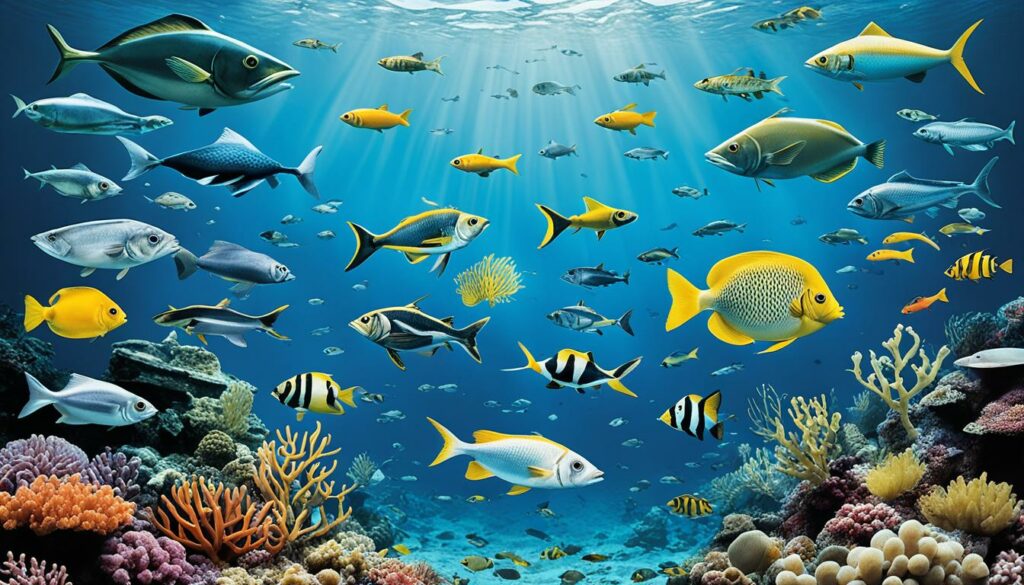
Every year, subsidies to encourage fishing reach $22.2 billion. These aids are crucial because without them, over half of the deep-sea fishing spots wouldn’t make economic sense. This fact raises big issues about sustainability and the need to review our support for fishing.
In places like Latin America, fishing is heavily influenced by these subsidies. Big fishing fleets get most of the support, but it’s the smaller local businesses that really boost the economy. For example, shrimp fishing in Latin America makes around $194 million each year and supports a lot of jobs.
A similar situation happens in West Africa, where a type of sardinella fishing creates many jobs. Yet, because of illegal practices, like IUU fishing, West Africa loses $2.3 billion annually. This huge loss shows why managing the use of subsidies is very important.
In the southern Pacific, Chinese and Taiwanese fishing boats need subsidies to stay afloat, so to speak. They can’t cover their costs just from fishing. This calls into question the whole idea of these supports, especially when we look at their impact on the world’s fish stocks.
In 2020, the world produced 214 million metric tons of fish, valuing the market at $406 billion. Shockingly, less than two-thirds of fish stocks are fished in a way that the stocks can recover. We need to find a better balance between supporting the economy and protecting our seas.
The world is eating more seafood, so we need sustainable fisheries. Traditional fishing has harmed many species. However, new aquaculture technologies might help us. They offer hope for the future by protecting wild fish and our oceans.
Fishing often catches more than fish; bycatch is a major issue. Only some fish are caught sustainably. Innovations in aquaculture, like New Zealand’s new fishing nets, can help. These new nets are kinder to the environment.
A U.S. firm, Radmantis, uses smart tech to keep fish healthy. This tech boosts aquaculture’s efficiency and cares for the fish better. As aquaculture grows, using advanced tech is key to protect our seas.
Blue tech is changing how we catch and farm fish, helping us feed the world. It includes smart boats and tracking systems to stop illegal fishing. These new ways ensure our fish supply is both plentiful and sustainable.
Reports show that one-third of global fish stocks are overfished. This contributes a lot to overfishing. It’s a big problem that we need to solve.
Overfishing affects the sea by ruining food chains and losing different species. This loss of variety can destroy the homes of sea life.
IUU fishing is against the law, hurting the sea and causing economic problems. It harms fisheries, threatens safety, and makes countries fight.
IUU fishing globally causes big economic losses. It weakens economies and harms the fishing industry by unfair competition and crime.
When using bad equipment, fisheries crimes increase waste and disturb the sea balance. This makes it harder to fish sustainably and stop illegal fishing.
Technologies like AIS and VMS, with satellite data and machine learning, help us track ships quickly. This makes it easier to check on fishing and enforce the rules.
UNCLOS is a key treaty that sets laws and rules for the oceans. It aims to save sea life by looking after fish in special areas and on the high seas.
The UN Fish Stocks Agreement helps different countries work together. They want to keep fish populations healthy through teamwork around the world.
RFMOs are groups that look after fish in certain parts of the world. They are very important for keeping fishing sustainable and protecting the seas.
The U.S. Coast Guard and NOAA work together to fight illegal fishing. They use patrols at sea and teach about good fishing methods.
The European Union says no to illegal fishing. They have strong rules to make sure seafood is caught legally. They do this to save the sea and keep fishing sustainable.
Overfishing hits hard on coast lives, especially in poorer nations. Less fish means less work. People might have to do bad things to get by, putting food and jobs at risk.
People are making laws and fighting for the sea, both locally and worldwide. They also teach about good fishing to protect sea life for our future.
Good plans include working together, following sustainable rules, and stopping bad subsidies. These efforts help fight illegal fishing and keep the sea safe.
Quotas control how much fish can be caught. This way, we don’t take too much and fish stocks can get healthy again. It helps keep the sea well-managed.
Working together helps share information and make and follow rules. It’s key to fighting illegal fishing and keeping fisheries safe everywhere.
Some subsidies make people fish too much because they’re not helpful. We need to check and change these so that fishing is done fairly and safely for the seas.
Fish farming can help meet the need for fish without using up too many wild ones. It’s a good way to help the sea stay healthy too.